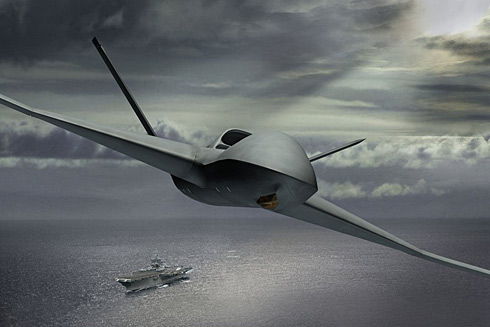Morning Coffee: Navy Leads Services in Robotic Strategy

Morning Coffee is a robust blend of links to news around the internet concerning the Naval Air Station Patuxent River economic community. The opinions expressed here do not necessarily reflect those of the Leader’s owners or staff.
The Air Force lauds the Navy as “way ahead” in developing an air-to-air platform for UCLASS (Unmanned Carrier-Launched Airborne Surveillance and Strike) aircraft, reports USNI. Also citing USNI as a source, io9 explains how the Navy’s proposed system to put a human pilot in the air commanding a fleet of robotic wingmen would work.
President Obama extended sequestration for another fiscal year, repealed a reduction in annual adjustments to military pensions and suspended the debt limit until March 15, 2015 by signing Senate bills 25 and 540 into law Feb. 16, according to a statement by the White House Press Secretary.
This time there are a bevy of reasons why a honing of defense acquisition laws will actually occur: Ranking members of the Pentagon and Congress are working in tandem to simplify military procurement laws. Dwindling budgets are contributing to the imperative as well, reports Defense News.
Flight of a second MQ-8C headlined defense media into the weekend, including this Australian Aviation report that Northrup Grumman flew its second MQ-8C Fire Scout unmanned helicopter at Point Magu, CA. The success puts two of the intelligence-gathering helicopters into active testing. The first MQ-8C flew in October and has logged 41 flights totally 66 hours. The government Down Under is renewing its interest in UAVs. The Australian reports the recently installed Liberal-National coalition is interested in reviving participation in the US Navy’s BAMS program. The Labor Party withdrew Australia from the program in 2009 after spending $100 million. Since then Northrop Grumman incorporated Australia’s early design requirements such as strengthened airframe and anti-icing equipment developing the Triton UAV.
Breaking Defense’ Sydney J. Freedberg Jr. suggests the MQ-8C could save the Littoral Combat Ship, a favorite of incoming SecDef Deputy Robert Work. The LCS was designed as a “modular mothership that could launch and control a wide variety of unmanned aircraft, mini-subs, and surface craft,” explains Mr. Freedberg who elsewhere describes Deputy Work’s support of a more robotic strategy in future combat, dubbed by Mr. Freedberg as the “network-of-robots concept.” The MQ-8C, a larger unmanned helicopter then Northrup’s successful MQ-8B, was designed to attain the distance, height and speed needed to best partner from such a mothership and grow the robotic network strategy.
“The time to start investing in the next generation of electronic warfare is now,” said Christine Fox, acting deputy defense secretary. Growing risks demand increased attention, already the Navy is leading electronic warfare technology development, reports DoD Buzz.
BAE’s Taranis UCAS is designed for stealth beyond counter-stealth radar, Aviation News reports on an analysis of the aircraft, suggesting thrust vectoring serves as a primary means of flight control and the presence of an innovative passive navigation and guidance system. The additional stealth, says the analysis, most likely seeks to avoid detection by very high frequency (VHF) early warning radars such as those being developed by Russia and China.
Pratt-Whitney’s JSF engine dominated sales at the Singapore Air Show, reports the company’s hometown paper Hartford Courant, the same week the Pentagon was reported to have reduced its JSF order for next year. The Singapore Air Show highlights the growing aerospace market in the Middle East and Asia. The International Air Transport Association reported a 5.3% increase in air traffic in the Asia Pacific region last year. The Navy brought its P-8A Poseidon aircraft to the show, reports the Navy Times, “to show the Navy’s commitment to regional partners and allies, and to highlight the Navy’s newest long-range anti-submarine warfare, anti-surface warfare, intelligence, surveillance and reconnaissance aircraft,” said Cmdr. Dan Papp, executive officer of VP-16.
“Run, hide, fight,” are among the directives Navy personnel and associates will practice as SOLID CURTAIN-CITADEL SHIELD 2014 unfolds February 24-28 across naval bases and installations throughout the National Capital Region. The Enterprise reports dovetailing local efforts included as part of the NAS:Patuxent River exercises. The Navy’s annual training exercise analyzes security responses during an emergency at an installation level. Additional security measures are expected to begin Feb. 18 at Pax:NAS and traffic delays are anticipated.
[youtube=http://www.youtube.com/watch?v=xgoKZxfn794]
Navmar Applied Sciences Corp., Warminster, Pa., a small business, is being awarded a $44,695,815 cost-plus-fixed-fee, firm-fixed-price contract for a Phase III Small Business Innovation Research (SBIR) effort in support of the Copperhead Unmanned Air Systems, specifically Tigershark Unmanned Aerial Vehicle (UAV). This project is for the improvement of sensor and platform capabilities, expansion to additional detachments and sustainment of current detachments. This contract includes continued improvements of the Tigershark UAV airframe, incorporation of improved sensors, and integration of improved command and control systems to current and future Copperhead platforms. Work will be performed in Afghanistan (50 percent); Patuxent River, Md. (25 percent); and Yuma, Ariz. (25 percent), and is expected to be completed in December 2014. Fiscal 2014 operation and maintenance, Army funds in the amount of $21,000,000 are being obligated on this award, all of which will expire at the end of the current fiscal year. This Phase III SBIR contract was not competitively procured pursuant to 10 U.S.C. 2304(c)(5). The Naval Air Warfare Center Aircraft Division, Lakehurst, N.J., is the contracting activity (N68335-14-C-0131).






















